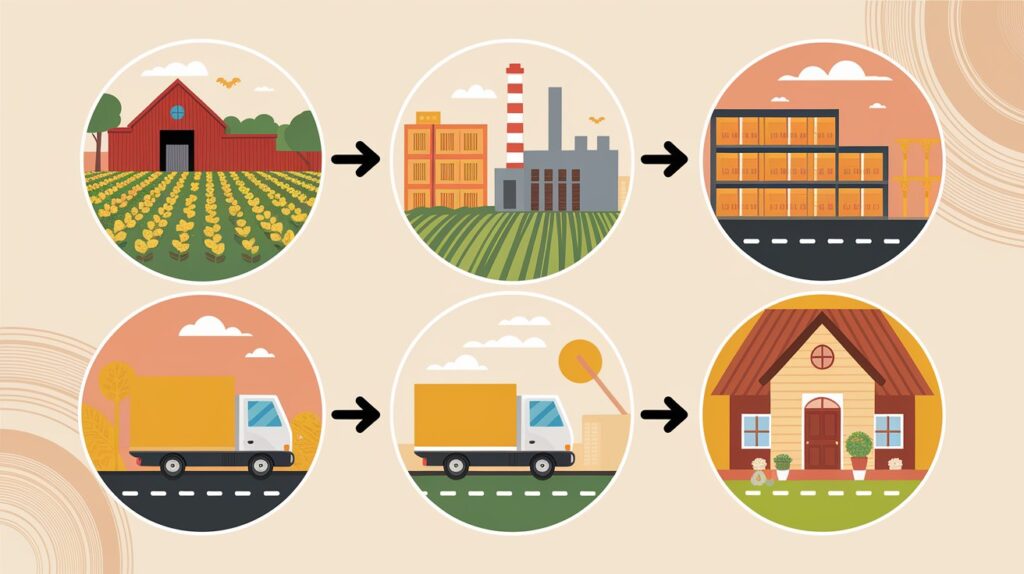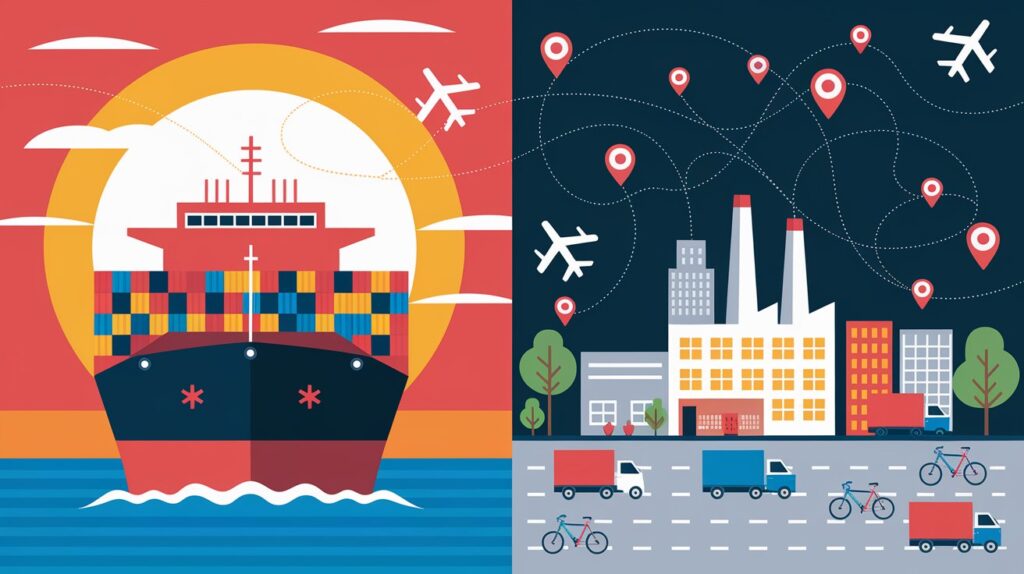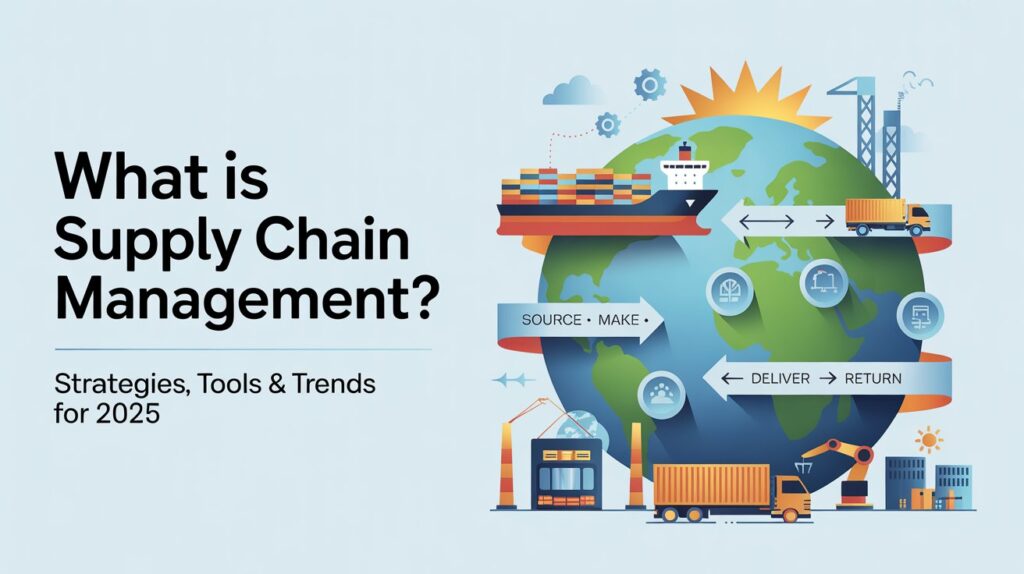Remember the empty shelves and delayed deliveries we all felt after the pandemic? Those headaches put supply chains on center stage. Supply chain management (SCM) is the art and science of moving a product from a raw idea to a happy customer’s hands—on time, at the right cost, and with as little waste as possible.
If you sell, make, move, or service anything, your supply chain is your lifeline. Getting it right can slash expenses, boost customer loyalty, and shield you from shocks like storms, strikes, or sudden tariff wars. Getting it wrong can sink your profits (and your reputation) in a heartbeat. Let’s break down what SCM really is, how it works in 2025, and what steps you can take today to tighten up your own operations.
Supply-Chain Fundamentals — The Players and the Big Picture
Key Parties
- Suppliers – provide raw materials or components.
- Manufacturers – turn inputs into finished goods.
- Third-Party Logistics (3PL) & Fourth-Party Logistics (4PL) partners – handle storage, transport, and sometimes the tech stack.
- Retailers / E-tailers – sell to the end customer.
- You (the Buyer) and your customers – whose needs steer every decision.
SCM vs. Logistics vs. Procurement
- Logistics is mainly about moving and storing goods.
- Procurement is about sourcing and buying.
- SCM sits above both, orchestrating every stage from initial forecast to final return.
The End-to-End Loop
Most experts map the flow as Source → Make → Deliver → Return. A true SCM view also folds in cash, data, and carbon flows—because money, information, and emissions travel right alongside your products.
Core SCM Processes (What Actually Happens Day-to-Day)

| Stage | What You Need to Nail | Pro Tips |
|---|---|---|
| Planning & Forecasting | Predict demand, set inventory targets | Use AI-based demand sensing to catch trends sooner |
| Sourcing & Procurement | Pick suppliers, negotiate cost & terms | Diversify across regions to avoid single-point failure |
| Production | Convert inputs into finished goods | Lean, agile, or continuous-flow lines depending on product mix |
| Inventory Management | Balance stock vs. service | ABC analysis, safety stock buffers, real-time tracking |
| Warehousing & Distribution | Store & move goods cost-effectively | Consider micro-fulfillment centers near major cities |
| Transportation & Last-Mile | Ship goods via truck, rail, air, ocean, bike | Optimize routes daily; explore green fuel options |
| Returns & Reverse Logistics | Handle product take-back, repair, recycling | Clear customer portal + refurbishing partnerships |
Each leg creates value only if the hand-offs are seamless. A snag in one link ripples through the rest, which is why end-to-end visibility is gold.
Supply-Chain Strategies — Finding the Right Fit for Your Business
- Push vs. Pull vs. Push-Pull Hybrids – High-volume basics often run best on push (produce to forecast), while custom items work on pull (produce to order). Many firms blend the two: push components, pull final assembly.
- Lean vs. Agile vs. Continuous-Flow – Lean trims fat; agile shifts fast; continuous-flow (think oil pipelines) hums non-stop. Your risk profile and demand volatility decide the mix.
- Global, Regional, Near-shored, Friend-shored – Rising freight costs and geopolitical flare-ups are nudging U.S. brands to move some production closer to home or to “friendly” trade partners.
- Vertical Integration vs. Outsourcing – Owning every node (à la Tesla gigafactories) can protect secrets and shorten lead times, but outsourcing (à la Apple’s Foxconn model) often frees cash for R&D.
Performance Metrics & KPIs — Know If You’re Winning
| KPI | Why It Matters |
|---|---|
| Perfect Order / OTIF (On-Time-In-Full) | Directly reflects customer satisfaction |
| Fill Rate & Back-order % | Spot shortages before they go viral on social media |
| Inventory Turnover & Days of Inventory on Hand (DOH) | Cut carrying costs—cash in your pocket |
| Cash-to-Cash Cycle Time | Shows how fast investedinstockturnsbackintoinvested in stock turns back intoinvestedinstockturnsbackinto in the bank |
| Forecast Accuracy (MAPE, bias) | Keeps you from over-or-under buying |
| Scope-3 Emissions & Waste | Now scrutinized by investors and regulators (EU CSRD goes live for many companies in 2025) |
Set targets, review them monthly, and tie bonuses to the metrics that really move the needle.

Technology & Digital Transformation — Your 2025 Tool Kit
- ERP & Advanced Planning Systems – Still the backbone; cloud-based suites now come with built-in AI assistants.
- IoT Sensors & Real-Time Visibility Platforms – Pallets “talk,” trucks ping their GPS every few minutes, and you get alerts before a cold-chain breach spoils your lettuce.
- AI & Machine Learning – From demand sensing that spots TikTok-driven spikes to dynamic routing that slashes idle miles. Generative-AI co-pilots even summarize disruption alerts and suggest fixes.
- Blockchain & Digital Passports – Secures provenance for luxury goods and pharmaceuticals, fighting counterfeits with immutable data trails.
- Robotics, Drones, and Autonomous Trucks – AMRs zip around warehouses; drones drop packages in rural areas; driver-assist platforms cut fatigue on long hauls.
- Digital Twins & Control Towers – A living 3-D model of your network lets you test “what if a port closes tomorrow?” without real-world pain.
- Cybersecurity & Zero-Trust – Every new device is a doorway; zero-trust frameworks lock each one.
Invest where the ROI is clear, pilot fast, and keep talent trained. The tech is only as smart as the people steering it.
Sustainability & Ethical Supply Chains
- Circular Economy & Closed-Loop Logistics – Designing products for disassembly keeps materials in play and cuts landfill fees.
- Regulatory Heat – The EU’s Corporate Sustainability Reporting Directive (CSRD) forces large enterprises (and many U.S. subsidiaries) to disclose Scope-3 emissions from 2025. Several proposals to “streamline” the rules are under debate, but the direction is unmistakable.
- SEC Climate Rule – U.S. filers may soon have to reveal supply-chain emissions and climate risks in 10-K filings, pending legal wrangling.
- Social Compliance & Modern-Slavery Audits – Forced-labor bans (e.g., Uyghur Forced Labor Prevention Act) demand chain-of-custody proof.
- Green Transport – From electric yard trucks to bio-fuel ocean carriers, greener miles are often cheaper over the asset’s life.
Your customers—and increasingly your investors—expect credible action, not slogans.
Risk Management & Resilience
- Threats to Watch: geopolitical conflict, pandemics, extreme weather, port cyber-attacks, strikes.
- Multi-Sourcing & Regional Diversification – Don’t bet your farm on one factory in one country.
- Scenario Planning & Stress Tests – Build “digital war games” that model 30-, 60-, and 90-day shutdowns.
- Strategic Inventory Buffers – “Safety stock” is back in fashion, but place it smartly (near key markets, not in slow locations).
- Business-Continuity Playbooks – Identify who calls who, what data you need, and which SKUs get priority if capacity is rationed.
A resilient supply chain may cost a bit more today but saves fortunes when (not if) the next disruption hits.
Top Trends Shaping SCM in 2025
- Generative AI Co-Pilots – Chat-style interfaces that draft supplier emails, summarize disruptions, and create draft network redesigns.
- Cost-to-Serve Analytics – CFOs want granular profit views to tame inflation and margin squeeze.
- ESG / Scope-3 Data Demands – Regulators and investors chase transparent carbon footprints.
- Near-Shoring & Micro-Factories – Shorter routes mean faster response and lower risk.
- Autonomous Mobile Robots (AMRs) – Quick to deploy, scalable, and cheaper than full-blown automation.
- “Supply-Chain-as-a-Service” Platforms – Outsource the heavy tech and focus on your brand.
- Quantum Optimization Pilots – Still early, but big players are testing quantum algorithms to crunch complex routing scenarios.
- Intake & Orchestration – Trend flagged by KPMG as firms centralize incoming orders and capacity assignments.
Stay curious; today’s edge quickly becomes tomorrow’s baseline.
Careers in Supply Chain Management
- Common Roles – Planner, buyer, logistics analyst, inventory manager, transportation manager, warehouse operations lead, and Chief Supply Chain Officer (CSCO).
- Must-Have Skills – Data storytelling, negotiation, tech fluency, cost analytics, and people leadership.
- Hot Certifications – APICS CPIM/CSCP, ISM CPSM, CSCMP SCPro, and Lean Six Sigma belts.
- Pay Range – The median U.S. salary for supply-chain managers sits around $110 K, and total packages can top $140 K with bonuses, according to recent surveys.
Demand keeps rising as CEOs tag supply chain as a top risk—and a top growth lever.
Implementing & Optimizing SCM in Your Business
- Assess Your Current State – Map every node, flow, and system. Identify pain points (late deliveries, high returns, excess stock).
- Set SMART Goals – “Cut transportation spend by 8 %” beats “get cheaper freight.”
- Pick a Tech Stack (Build vs. Buy) – Cloud suites get you speed; bespoke builds give you fit. Many firms blend both: buy core, build secret sauce.
- Form a Cross-Functional Governance Team – Finance, sales, procurement, ops, IT, and sustainability should all have a seat—and skin in the game.
- Lean & Six Sigma for Continuous Improvement – Tiny daily tweaks beat yearly heroic overhauls.
- Mini Case Snaps
- Toyota – Pioneered Just-In-Time, shaving space and cash tied up in stock.
- Zara – Near-shore sewing in Spain & Portugal lets it turn catwalk trends into shelves in weeks.
- Amazon – Uses predictive inventory and same-day hubs to make “Buy Now” feel instant.
Start small, iterate fast, measure relentlessly.
Common Challenges & How You Can Beat Them
| Challenge | Action Plan |
|---|---|
| Data silos, legacy systems | Use middleware APIs; push for one “single source of truth.” |
| Demand swings & black-swans | Shorten forecast cycles; adopt real-time POS feeds. |
| Supplier shortages | Dual-source critical parts; lock in capacity contracts. |
| Rising logistics costs | Redesign network; shift modes (rail over air), load-pool with peers. |
| Compliance complexity | Plug automated reporting tools into your ERP; stay audit-ready. |
The secret is steady refinement—no chain stays perfect for long.
Frequently Asked Questions
Is SCM only for large enterprises?
No. Even a home-based Etsy shop has a micro supply chain—raw materials, production steps, and shipping. Good SCM scales to your size.
How does SCM differ from operations management?
Ops focuses on what happens inside your four walls. SCM spans everything outside too—suppliers upstream, customers downstream.
What software is best for small businesses?
Look for cloud platforms with modular pricing—start with inventory and shipping, add planning later.
Do I need blockchain?
Only if you face counterfeits or strict provenance rules (luxury, pharma, food traceability). Otherwise, standard traceability tools may suffice.
How can AI help my forecast?
AI can read social chatter, weather, and POS spikes faster than a human—and send you a digest with suggested order changes.
Key Takeaways & Next Steps
Your supply chain is no longer just a cost center; it’s your growth engine and your reputational armor.
If you:
- Map your flows,
- Track the right KPIs,
- Invest in smart tech, and
- Build a sustainability and risk-ready mindset,
you’ll serve customers better, free up cash, and sleep easier when the next shock hits. Start this week by picking one KPI to improve and one low-hanging tech pilot (say, real-time truck tracking). Your future self—and your customers—will thank you.

